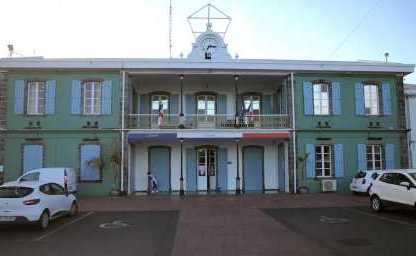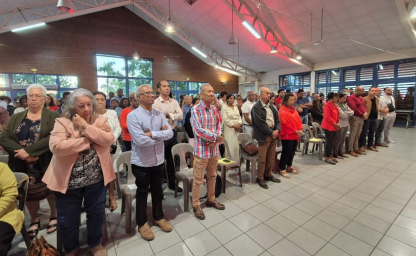
Turbulence à la Mairie de Saint-André
5 juillet, parAprès les coupures d’eau mémorables sur fond de polémique, le conflit Mairie de Saint-André-Cirest qui perdure, les plaintes à répétition, les (…)
33 years after ’Peuple de La Réunion - Peuple du Maloya’
2 October 2009

Maloya is among the 76 elements inscribed on 30 September on UNESCO’s Representative List of the Intangible Cultural Heritage of Humanity. Maloya is a form of music, song and dance native to Réunion Island. Of mixed racial origins since its outset, maloya was created by Malagasy and African slaves on the sugar plantations and was eventually appropriated by the whole of the island’s population. Initially conceived as a dialogue between a soloist and a choir accompanied by percussion instruments, maloya exists today in an increasing variety of forms, both in terms of texts and instruments (the introduction of djembes, synthesizers, drums, etc.). Following some parts of the nomination form published on the UNESCO’s website.
Maloya designates a type of music, a song, a dance specific to Reunion. Brought by slaves from East Africa and Madagascar, it became creolized on the sugar plantations during the period of “engagism”. Long linked to ceremonies of ancestor worship, and confined to the sphere of the plantations and the housing for farm labourers and sugar-factory workers, it has been gradually moving into the public domain since the 1970s. It was used to convey political demands during the 1960s-1980s, and has become today the main expression of the identity of Reunion at the cultural and musical level. More than 300 musical groups perform maloya. It has long been performed by family groups who exchange and pass on knowledge and know-how. It took the form of a dialogue between a soloist and a chorus. Maloya is now sung and danced on stage by professional and semi-professional groups of musicians and the style of the text is much more varied. Many CDs are produced each year and many tours are organized nationally and internationally. Many forms drawing on different cultural sources now exist: maloya-rock, maloya-reggae (malogué), maloya-fusion, maloya-jazz, and so on.
Maloya designates a sung and danced form which is usually identified as being of African and Malagasy origin or affinity. Brought by African and Malagasy slaves and then engages (indentured labourers), it was soon described and represented, under the term “tchéga”, in eighteenth- and nineteenth-century travellers’ tales and lithographs. Maloya is a remarkably clear example of the processes of cultural creolization which took place in the context of sugar plantations, in particular upon contact with indentured labourers from the villages of southern India who brought with them melodies, sagas, myths and rituals.
The sung texts of “traditional” maloya also drew upon eighteenth- and nineteenth-century French ballads. The word “maloya”, whose probable Malagasy or East African etymology remains uncertain, then became widespread. In its traditional form, the maloya song is performed in alternation between the soloist and chorus. It is accompanied by drums (roulèr), idiophones (pikèr, sati) and rattles (kayamb). In addition to these instruments, the bob (a one-string percussion instrument), other recently introduced percussion instruments such as djembés from West Africa and congas from Latin America and, in the case of electric maloya, modern instruments (guitars, synthesizers, bass, drums, etc.) are used according to the performance forms and the contexts. The texts of maloya are generally composed in Creole, although a creolized Malagasy form is sometimes used.
Initially, maloya was performed within a ritual framework called servis malgas or servis kabaré. These were ceremonies where animals were sacrificed as offerings to the Malagasy or African ancestors who were being honoured. The songs were used to initiate communication with the ancestors and to keep some of the participants in a state of possession.
Historically performed in the family circle and the close neighbourhood, some servis became increasingly public or semi-public. Until the 1960s, maloya was also performed during festive evenings (maloya balls) with dancing and the improvisation of songs of criticism and social commentary. Maloya was then an aspect of social regulation within the communities of sugar plantation workers. Since the 1970s and 1980s, maloya has become a major vector for political and cultural demands and for identity-building. Recordings are frequently issued of maloya in its neo-traditional form or more modern adaptations (fusion with reggae, jazz, rock, folk music, rap, and so on).
It is now the very symbol of the cultural identity of all the generations in Reunion. No festive or cultural event in neighbourhoods, villages or on a broader level takes place without maloya. The high point of maloya’s visibility comes on the occasion of the cultural events that take place throughout the island and in the diaspora on 20 December, anniversary of the abolition of slavery in Reunion. Throughout the night, the troupes follow one another, either on podiums set up by public authorities, or in kabar organized in a more or less ad hoc manner in courtyards and other private spaces.

Après les coupures d’eau mémorables sur fond de polémique, le conflit Mairie de Saint-André-Cirest qui perdure, les plaintes à répétition, les (…)

Le CIOM « national » aura bien lieu le 10 juillet au Ministère des Outre-mer, en présence du Premier ministre, François Bayrou et du ministre de (…)

Kan i ariv Novanm-Désanm-Zanvié, domoun i réziste pi ek la salèr. Zène-zan i mars dann somin, zène-fi i roul an dékolté ; sétaki i rod in manir po (…)

En avril 2025, la ministre malgache des Affaires étrangères, Rasata Rafaravavitafika a déclaré que "la position de Madagascar concernant la (…)

L’ancien chef de la diplomatie européenne a déclara qu’« en un mois, 550 Palestiniens affamés ont été tués par des mercenaires américains ». Une (…)

Après l’opération militaire d’Israël « Rising Lion » (« Lion dressé ») contre l’Iran dans la nuit du jeudi 12 au vendredi 13 juin 2025, et celle (…)

Les cours du pétrole ont connu une nette hausse à partir de la deuxième quinzaine du mois de juin, portés par l’extrême tension au Moyen-Orient et (…)

La Réunion fait partie des régions françaises les plus touchées par les conséquences sanitaires, sociales et judiciaires de la consommation (…)

1993- La disparition de Lucet Langenier. Elle a été brutale, prématurée et a frappé douloureusement non seulement sa famille mais aussi ses (…)

Sur proposition de Gérard COTELLON, directeur général de l’ARS La Réunion, Patrice LATRON, préfet de La Réunion, a décidé le retour au niveau 2 du (…)

C’est dans une ambiance chaleureuse avec un état d’esprit fraternel que les délégués de la Section PCR de Sainte-Suzanne se sont réunis en (…)

La section PCR du Port apprend avec une profonde tristesse le décès de Nadia PAYET, ancienne déléguée syndicale CGTR. Militante engagée et (…)